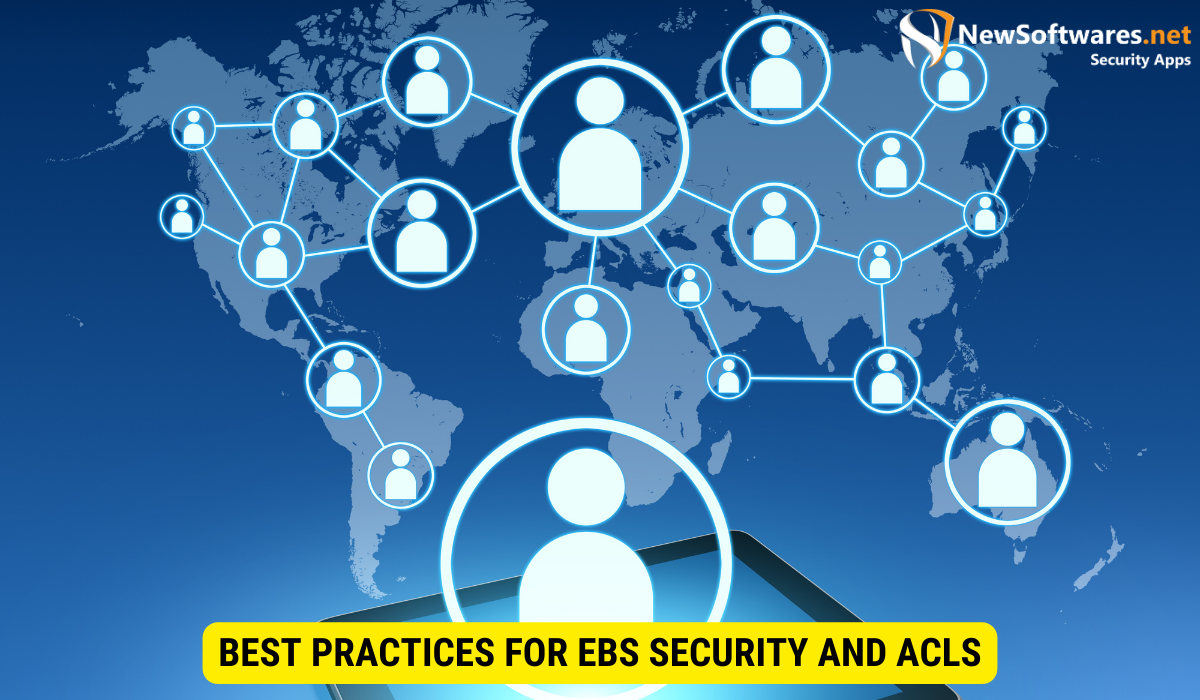To secure data at rest in EBS security groups and ACLs, you can employ encryption techniques, implement Identity and Access Management (IAM), conduct regular auditing and monitoring, and follow best practices for configuring security groups and ACLs.
In today’s digital age, data security is of utmost importance. As businesses & individuals increasingly rely on cloud storage solutions, securing data at rest is imperative, particularly within Elastic Block Store (EBS) security groups and Access Control Lists (ACLs). In this article, we will explore the various approaches and strategy to ensure the safety and confidentiality of data at rest in EBS security groups and ACLs.
Understanding Data at Rest in EBS Security Groups

Before diving into securing data, let’s define what we mean by “data at rest.” Data at rest refers to any digital information stored or retained in a persistent storage medium, for example a hard disk or solid-state drive, without being actively processed or in transit. In the context of EBS security groups, data at rest pertains to the data stored within the Elastic Block Store volumes attached to Amazon EC2 instances.
Defining Data at Rest
Data at rest can take various forms, including databases, files, virtual machine images, etc. It encompasses structured and unstructured data, covering a wide range of information stored within EBS volumes. Understanding the nature and sensitivity of the data at rest is crucial to identify the appropriate security measures that need to be implemented.
Importance of Securing Data at Rest
Securing data at rest is essential for several reasons. first of all, it ensures the confidentiality and privacy of sensitive information, preventing unauthorized access and potential data breaches. Secondly, compliance with industry regulations and data protection standards often necessitates implementing robust security measures for data at rest. Lastly, securing data at rest helps safeguard data loss because of hardware failures, accidental deletions, or natural disasters.
Role of EBS Security Groups in Data Protection
EBS security groups protect data at rest within the Elastic Block Store volumes. These are virtual firewalls that control inbound and outbound traffic to EC2 instances. By carefully configuring EBS security groups, you can restrict network access to your instances, thereby reducing the attack surface and minimizing the danger of unauthorized access to data at rest.
Key Concepts in EBS Security Groups and ACLs
To effectively secure data at rest, it is essential to have a firm understanding of key concepts related to EBS security groups and ACLs.
Overview of EBS Security Groups
EBS security groups operate at the instance level and act as the first line of defense to control inbound and outbound traffic. They are analogous to a firewall, allowing you to define rules that permit or deny network traffic based on IP addresses, protocols, and ports. By carefully crafting EBS security group rules, you can ensure that only authorized systems and users can access the data at rest within your Elastic Block Store volumes.
Understanding ACLs (Access Control Lists)
In addition to EBS security groups, Access Control Lists (ACLs) provide an additional layer of network security for Amazon VPC subnets. While EBS security groups focus on controlling traffic at the instance level, ACLs operate at the subnet level. ACLs help regulate inbound and outbound traffic at the network level and enable you to control access between subnets within your VPC. Understanding the interplay between security groups and ACLs is crucial to effectively secure data.
Interplay between Security Groups and ACLs
Security groups and ACLs work together to provide comprehensive network security for your EC2 instances and data. While security groups control traffic at the instance level, ACLs act as a subnet-based firewall. It is important to align the rules defined in security groups and ACLs to ensure that only authorized traffic flows to and from your instances, further fortifying the security of your data at rest.
Strategies for Securing Data at Rest
Now that we have established an understanding of EBS security groups and ACLs, let’s delve into some strategies for securing data at rest within these environments.
Encryption Techniques for Data at Rest
Encryption serves as a powerful mechanism for protecting data at rest. Encrypting your EBS volumes ensures that even if an unauthorized party gains access to the underlying storage, the data remains unreadable without the appropriate decryption key. Amazon Web Services (AWS) provides several options for encrypting EBS volumes, including AWS Key Management Service (KMS) and customer-managed keys. Implementing encryption is a fundamental step in safeguarding sensitive data at rest.
Implementing Identity and Access Management (IAM)
Identity and Access Management (IAM) is one more critical aspect of securing data at rest. By managing user access and permissions effectively, you can ensure that only authorized users can act with the data stored within EBS volumes. IAM allow you to create and manage user accounts, define granular permissions, and enforce Multi-Factor Authentication (MFA), providing additional data protection.
Regular Auditing and Monitoring
An often-overlooked aspect of securing data at rest is regular auditing and monitoring. You can quickly detect and respond to latent security incidents or unauthorized access attempts by implementing real-time monitoring and log analysis. Continuously auditing and reviewing security configurations, access logs, and alerts allows you to proactively identify and remediate any potential vulnerabilities or misconfigurations, bolstering the security and integrity of data at rest.
Now that we have discussed strategies for securing data at rest, let’s explore some best practices for configuring and managing EBS security groups and ACLs.
Configuring Security Groups
When configuring EBS security groups, following the principle of least privilege is crucial. Only allow the inbound and outbound traffic required for your applications to function properly. Review and assess your security group rules to identify unnecessary open ports or overly permissive access controls. Additionally, consider utilizing Security Group rules to restrict administrative access to the instances storing data at rest.
Setting Up ACLs
When setting up ACLs, it is important to carefully define the rules to allow legitimate traffic while denying unauthorized access. ACLs operate on a first-match basis, so order the rules accordingly. Review and update your ACL rules to align with your evolving network requirements and security policies. Additionally, be cautious when modifying ACL rules for subnets containing data at rest to maintain the integrity and security of your stored information.
Continuous Improvement and Updates
The field of data security is constantly evolving, with new threats and vulnerabilities emerging regularly. It is very important to stay current with the latest best practices, security recommendations, and updates from AWS. Regularly monitor AWS documentation, security bulletins, and forums to ensure that you are aware of any new security features or patches that can enhance the security posture of your EBS security groups and ACLs.
Key Takeaways
- Data at rest refers to stored digital information that is not actively being processed or transmitted.
- EBS security groups and ACLs are key components for protecting data at rest within Elastic Block Store volumes.
- Encryption, IAM, and regular auditing are essential to securing data at rest.
- Proper configuration of security groups and ACLs, following the principle of least privilege, is crucial.
- Continuous improvement and staying up to date with the latest security recommendations are essential for maintaining a secure data storage environment.
FAQs
Q: Can I use my encryption keys with EBS?
A: You can use AWS Key Management Service (KMS) to manage your own encryption keys or leverage customer-managed keys for greater control over your data at rest encryption.
Q: What are the benefits of regularly auditing and monitoring security configurations?
A: Regular auditing and monitoring allow you to quickly detect and respond to potential security incidents, identify misconfigurations & ensure compliance with security best practices.
Q: How can IAM help secure data at rest in EBS volumes?
A: IAM allows you to manage user access and permissions, enforce strong authentication mechanisms, and implement granular access controls, thus reducing the risk of unauthorized access to data at rest.
Q: Can I take any additional measures to secure data at rest?
A: Alongside encryption, IAM, and auditing, you can put into practice additional security measures for instance multi-factor authentication, vulnerability scanning, and intrusion detection systems to enhance the data security posture.
Q: How frequently should I review and update security group and ACL rules?
A: It is recommended to regularly review & update security group and ACL rules, particularly when changes in your network infrastructure, application requirements, or new security threats and vulnerabilities emerge.
Conclusion
Securing data at rest within EBS security groups and ACLs is critical to maintaining the confidentiality, integrity, and availability of sensitive information. By leveraging encryption, implementing strong access controls, and continually auditing and monitoring your security configurations, you can enhance the protection of data stored within Elastic Block Store volumes. Regularly reviewing and updating security group and ACL rules, staying advanced with the latest security recommendations, and following best practices will help ensure your data’s ongoing security and compliance at rest in EBS security groups and ACLs.

